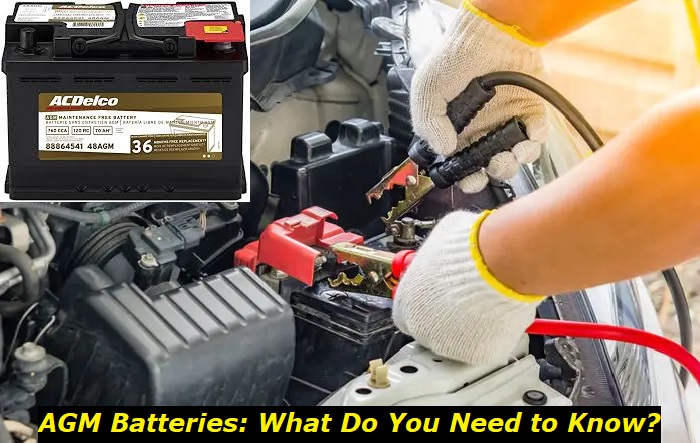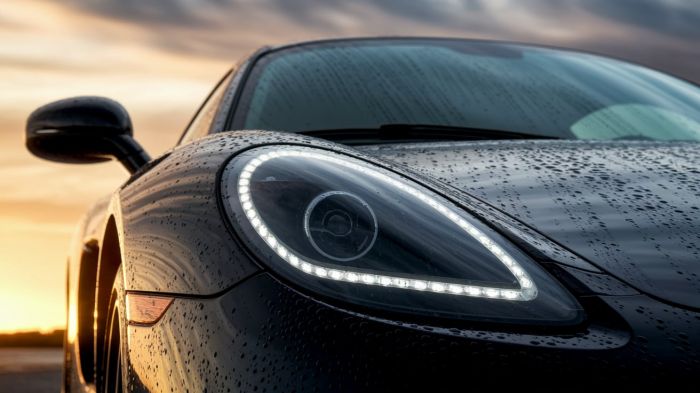The discharge limit of an AGM battery is 50%. It should only be on this mark or above. And the higher the discharge limit is, the better it will be for your battery. Find out what this benefit is and more as you read further. We've also described the right way to use your unit, especially in the "maintenance" section.
Car battery voltage highlights
- Optimal conditions:12.4 - 12.5 volts
- When charging:14.3 - 14.7 volts
- Alarming voltage:less than 12 volts
- Acceptable drop when loaded:up to 10.5 volts
- Fix for low voltage:charging or replacement
- DIY fix:possible
- How much to fix? $0 - $250

What Are AGM Batteries?
1) In Military Application/History
AGM tech was popularized in the 80s as a sealed lead acid battery. It was designed for military use in vehicles, aircraft, etc. This was because of its reliability and lower weight.
The battery's spill-proof feature also enabled it to be shipped easily without worrying much about hazardous material regulations. The plates could be adjusted to be flat in a semblance of a regular flooded lead acid pack contained in a rectangular structure. They could also be made into a cylindrical formation.
2) Modern Description
AGM batteries are still basically lead acid batteries, but they're more advanced than the regular lead acid types. They feature fine glass fiber separators between the negative and positive plates which helps in absorbing the battery's acid. The acid or electrolyte is soaked in the fiberglass.
AGM types are graded over three capacity discharge times-C10, C20, and C100. This is related to the power the battery has in 10 hours, 20 hours, and 100 hours respectively.
There has been a rise in the need for vehicle batteries that are strong enough for off-grid living or outings in recent years. Vehicle users especially those who use leisure vehicles haven't been satisfied with the juice they get from the old wet lead acid types.
However, power isn't the only issue. They're also preferring products that require little or no maintenance. That's where batteries like the AGM types come in. It's also a low-gas option that can handle regular recharging and discharging. This battery is engineered for multiple applications.
Now, AGM batteries have become a very popular product in regular cars. They're also used in bigger vehicles, as stated earlier. Maybe it's time you also looked into getting one. And if you already own one, then you should value it more and treat it with additional care.
Shoppers who are searching for true deep cycle battery types made for regular recharging and discharging will find AGM batteries to be suitable for such expectations. You won't need to top it up with water, it doesn't spill, it charges faster, and it has high durability.
All you have to do to get the best from your AGM battery is to dedicate adequate time to implement the correct charging procedure. You'll be able to get an improved output from such a maintenance culture. It will definitely be better than what's obtainable when using regular wet lead acid batteries.
More Advantages of AGM Batteries
Owners of racing cars, boats, and so on are switching to the use of AGM batteries. Let's not forget RV or leisure vehicle users. There are too many "pros" to benefit from. We've given a description of many of the advantages in this section.
Firstly, the units possess low internal resistance and can provide high currents when needed. They offer a comparatively long service life even with deep cycling. There's also the reliable electrical features as an added advantage.
AGM batteries have lower susceptibility to sulfation than regular lead acid types and they can be stored for longer periods. On the other hand, regular lead acid units require a topping charge every six months to avoid accumulated sulfation.
The AGM types experience low self-discharge and can withstand low temperatures. But handling high temperatures is a different ball game for this product. We'll elaborate further on this under the "maintenance tips" section.
Absorbent Glass Mat batteries are also good for cars that have start-stop functionality. The traditional flooded type isn't strong enough and it can't handle the frequent cycle repetitions. The AGM types can withstand the frequency and won't experience a decline in capacity easily.
One of the best merits of this battery type is that it can charge about five times quicker than the flooded types. This is in addition to the unit's deep cycling ability. Lastly, AGM batteries are cheaper than gel batteries, so you may want to opt for them if affordability is an issue.
Demerits of AGM Batteries
Although AGM batteries are more affordable than gel batteries, it doesn't take away the fact that they're costlier than regular lead acid batteries. And this is due to the higher cost of manufacturing them.
Sensitivity to high voltages and overcharging is another disadvantage. Although the electrical workings of the battery are still considered some of the best.
The fact that they have to be fully charged between uses is another hassle that may discourage shoppers and also be difficult for some users to sustain. For example; off-grid/leisure vehicle owners.
Battery age is a factor that negatively affects AGM batteries-just like other battery types. It will start experiencing a decline in its capacity, charging speed, discharge time, etc. This is however not as bad as it is for regular lead-acid units.
AGM Battery Maintenance Tips
Every battery needs to be properly maintained and/or used. And that goes for AGM batteries with such high output expectations. Although Absorbent Glass Mat products are meant to require no maintenance. Still, you should consider the tips given in this section as maintenance guidelines.
A good maintenance culture is essential, especially for those who use AGM batteries for leisure vehicles or off-grid living. It's also important if you're taking long breaks from utilizing the battery. The following key tips should be followed for AGM battery maintenance:
1) Charge the Battery Fully
Make sure that the unit is completely charged before unplugging from the power source. It should read at least 13 volts. The chosen final charging profile must be AGM-optimized.
2) Don't Leave the Unit on Permanent Charge or Trickle
Long-term charging will make the unit dry out even if the battery doesn't feature free-flowing electrolytes. Make sure you charge the unit once every month (overnight) after a full charge when it's in storage.
3) Ensure That the Battery Isn't Heating Up Too High
Sealed battery types like AGM don't like excess heat. That's why it's recommended to install them away from the engine compartment. So your unit shouldn't be near a heat source when stored.
4) Charge in Moderate Temperatures
You shouldn't charge the unit in extreme temperatures. This goes for low temperatures as well even if the battery can withstand such temperatures in storage or in the vehicle. Stop charging it if the core hits 120°F (49°C). Charge the battery when the temperature is 0°C-40°C to ensure its longevity.
5) Utilize Chargers Recommended by the Manufacturer
AGM batteries are "choosy" when it comes to chargers. In other words, they're charger-specific. This is something that has been set from the factory by the manufacturers. So make sure that you use the charger that was recommended for the product.
Each Absorbent Glass Mat battery charger offers adequate voltage for the unit it was made for. Utilizing the wrong charging device may lead to shorting in the unit.
There's also size compatibility when it comes to the chargers. A big AGM battery can only be matched by a big charger in terms of capacity. The capacity is typically stated in amperes. That's what you'll use to determine charger suitability when shopping for one.
5) Limit the Maximum Discharge Level to 50%
As stated earlier in the introduction, 50% should be the maximum discharge level. It could be less, but your unit's cycle life will decrease in reaction. Discharging above the 50% limit always will enhance the cycle life.
The battery's cycle life will determine the battery's life span. The battery won't stop functioning, and neither will it get irreparable. But you'll realize that it's experiencing less running time after completing the cycle.
Note: Battery warranty doesn't cover loss of capacity because such aspect is influenced by the unit's usage, your charging culture, etc.
Conclusion
AGM batteries aren't charged the same way as the wet lead acid, gel, and carbon AGM types. These battery types also operate in different ways, although each may share some similarities to the other.
Try to maximize the total potential of your Absorbent Glass Mat battery by doing all the research you can on its proper usage, charging method, and maintenance. Nonetheless, the information in this guide should be more than enough basic knowledge for any AGM type user.
About the authors
The CarAraC research team is composed of seasoned auto mechanics and automotive industry professionals, including individuals with advanced degrees and certifications in their field. Our team members boast prestigious credentials, reflecting their extensive knowledge and skills. These qualifications include: IMI: Institute of the Motor Industry, ASE-Certified Master Automobile Technicians; Coventry University, Graduate of MA in Automotive Journalism; Politecnico di Torino, Italy, MS Automotive Engineering; Ss. Cyril and Methodius University in Skopje, Mechanical University in Skopje; TOC Automotive College; DHA Suffa University, Department of Mechanical Engineering






Add comment